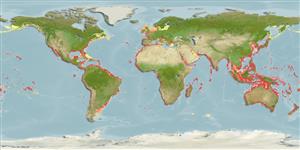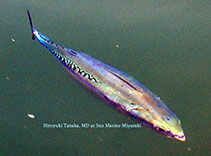Add your observation in Fish Watcher
| Native range | All suitable habitat | Point map | Year 2050 |

|
| This map was computer-generated and has not yet been reviewed. |
| Auxis rochei AquaMaps Data sources: GBIF OBIS |
Upload your photos and videos
Pictures | Google imageAuxis rochei
Picture by Tanaka, H.
Pictures | Google imageAuxis rochei
Picture by Tanaka, H.
Indonesia country information
Common names:
Babalaki, Aya selaseh, Bakulan
Occurrence: native
Salinity: brackish
Abundance: | Ref:
Importance: highly commercial | Ref:
Aquaculture: | Ref:
Regulations: | Ref:
Uses: no uses
Comments:
National Checklist:
Country Information: https://www.cia.gov/library/publications/resources/the-world-factbook/geos/id.html
National Fisheries Authority:
Occurrences: Occurrences Point map
Main Ref: Collette, B.B. and C.E. Nauen, 1983
National Database:
Occurrence: native
Salinity: brackish
Abundance: | Ref:
Importance: highly commercial | Ref:
Aquaculture: | Ref:
Regulations: | Ref:
Uses: no uses
Comments:
National Checklist:
Country Information: https://www.cia.gov/library/publications/resources/the-world-factbook/geos/id.html
National Fisheries Authority:
Occurrences: Occurrences Point map
Main Ref: Collette, B.B. and C.E. Nauen, 1983
National Database:
Common names from other countries
Classification / Names Nombres comunes | Sinónimos | Catalog of Fishes(Género, Especie) | ITIS | CoL | WoRMS | Cloffa
> Scombriformes (Mackerels) > Scombridae (Mackerels, tunas, bonitos) > Scombrinae
Etymology: Auxis: Greek, auxis = a variety of tunna (Ref. 45335).
Eponymy: Dr François-Etienne de la Roche (or Delaroche) (1780–1813) was a Swiss physician, chemist, botanist and ichthyologist, who qualified as a physician in Paris (1808) and worked at the Hospice Necker. [...] (Ref. 128868), visit book page.
More on author: Risso.
Etymology: Auxis: Greek, auxis = a variety of tunna (Ref. 45335).
Eponymy: Dr François-Etienne de la Roche (or Delaroche) (1780–1813) was a Swiss physician, chemist, botanist and ichthyologist, who qualified as a physician in Paris (1808) and worked at the Hospice Necker. [...] (Ref. 128868), visit book page.
More on author: Risso.
Environment: milieu / climate zone / depth range / distribution range Ecología
marino; salobre; oceanodromo (Ref. 51243); rango de profundidad 10 - ? m (Ref. 9340). Tropical; ? - 28°C (Ref. 168); 61°N - 51°S, 180°W - 180°E
Distribución Países | Áreas FAO | Ecosistemas | Ocurrencias, apariciones | Point map | Introducciones | Faunafri
Atlantic, Indian and Pacific (Western): including the Mediterranean Sea. The eastern Pacific population is recognized as subspecies Auxis rochei eudorax (Ref. 32349). Highly migratory species.
Length at first maturity / Tamaño / Peso / Age
Maturity: Lm ?, range 35 - ? cm
Max length : 50.0 cm FL macho / no sexado; (Ref. 168); edad máxima reportada: 5 años (Ref. 125574)
Max length : 50.0 cm FL macho / no sexado; (Ref. 168); edad máxima reportada: 5 años (Ref. 125574)
Short description Claves de identificación | Morfología | Morfometría
Espinas dorsales (total) : 9 - 12; Radios blandos dorsales (total) : 10 - 13; Espinas anales: 0; Radios blandos anales: 12 - 14. Back bluish, turning to deep purple or almost black on head. Scaleless area with pattern of 15 or more fairly broad, nearly vertical dark bars. Belly white. Pectoral and pelvic fins purple, their inner sides black. Body robust, elongate and rounded. Teeth small and conical, in a single series. Pectoral fins short, not reaching vertical line from anterior margin of scaleless area above corselet. A large, single-pointed flap (interpelvic process) between pelvic fins. Body naked except for corselet, which is well developed in its posterior part 9 more than 6 scales wide under second dorsal-fin origin). A strong central keel on each side of caudal-fin base between 2 smaller keels (Ref 9684).
Adults are principally caught in coastal waters and around islands (Ref. 9340). Form schools. Feed on small fishes, particularly anchovies, crustaceans (especially crab and stomatopod larvae) and squids. Eggs and larvae are pelagic (Ref. 6769). Because of their abundance, they are considered an important element of the food web, particularly as forage for other species of commercial interest. Also caught with encircling nets and troll lines (Ref. 9340). Marketed fresh and frozen (Ref. 9340) and also dried or salted, smoked and canned (Ref. 9987).
Life cycle and mating behavior Madurez | Reproducción | Puesta | Huevos | Fecundidad | Larva
Fecundity ranges between 31,000 and 103,000 eggs per spawning according to the size of the fish.
Main reference
Upload your references | Referencias | Coordinador : Collette, Bruce B. | Colaboradores
Collette, B.B. and C.R. Aadland, 1996. Revision of the frigate tunas (Scombridae, Auxis), with descriptions of two new subspecies from the eastern Pacific. Fish. Bull. 94(3):423-441. (Ref. 32349)
IUCN Red List Status (Ref. 130435: Version 2024-2)
Least Concern (LC) ; Date assessed: 01 March 2022
Threat to humans
Harmless
Human uses
Pesquerías: muy comercial; pesca deportiva: si
FAO(pesquerías: producción, species profile; publication : search) | FIRMS (Stock assessments) | FishSource | Sea Around Us
Más información
Trophic ecology
componentes alimenticios
Composición de la dieta
consumo de alimento
Food rations
Despredadores
componentes alimenticios
Composición de la dieta
consumo de alimento
Food rations
Despredadores
Population dynamics
Coeficiente del crecimiento para
Max. ages / sizes
Length-weight rel.
Length-length rel.
Length-frequencies
Mass conversion
Reclutamiento
Abundancia
Coeficiente del crecimiento para
Max. ages / sizes
Length-weight rel.
Length-length rel.
Length-frequencies
Mass conversion
Reclutamiento
Abundancia
Life cycle
Reproducción
Madurez
Fecundidad
Puesta
Spawning aggregations
Huevos
Egg development
Larva
Dinámica larvaria
Reproducción
Madurez
Fecundidad
Puesta
Spawning aggregations
Huevos
Egg development
Larva
Dinámica larvaria
Anatomy
Superficie branquial
Brain
Otolith
Superficie branquial
Brain
Otolith
Physiology
Body composition
Nutrients
Consumo del oxígeno
Tipo de natación
Velocidad de natación
Visual pigments
Fish sound
Diseases & Parasites
Toxicity (LC50s)
Body composition
Nutrients
Consumo del oxígeno
Tipo de natación
Velocidad de natación
Visual pigments
Fish sound
Diseases & Parasites
Toxicity (LC50s)
Genetics
Genética
Heterozygosity
heritabilidad
Genética
Heterozygosity
heritabilidad
Human related
Aquaculture systems
Perfiles de acuicultura
Razas
Ciguatera cases
Stamps, coins, misc.
Aquaculture systems
Perfiles de acuicultura
Razas
Ciguatera cases
Stamps, coins, misc.
Herramientas
E-book | Guía de campo | Claves de identificación | Asistente para frecuencias de tallas | Herramienta de ciclo de vida | Mapa de puntos | Classification Tree
| Catch-MSY |
Special reports
Download XML
Fuentes de Internet
Aquatic Commons | BHL | Cloffa | BOLDSystems | Websites from users | Check FishWatcher | CISTI | Catalog of Fishes(Género, Especie) | DiscoverLife | ECOTOX | Faunafri | Fishtrace | GenBank(genome, nucleotide) | GloBI | GOBASE | | Google Books | Google Scholar | Google | IGFA World Record | MitoFish | Bases de datos nacionales | Otolith Atlas of Taiwan Fishes | PubMed | Reef Life Survey | Scirus | SeaLifeBase | Árbol de la vida | Wikipedia(Go, búsqueda) | World Records Freshwater Fishing | Expediente Zoológico
Estimates based on models
Preferred temperature (Ref. 115969): 13.6 - 29, mean 26 (based on 6786 cells).
Phylogenetic diversity index (Ref. 82804): PD50 = 0.5625 [Uniqueness, from 0.5 = low to 2.0 = high].
Bayesian length-weight: a=0.00955 (0.00828 - 0.01101), b=3.06 (3.02 - 3.10), in cm Total Length, based on LWR estimates for this species (Ref. 93245).
Nivel trófico (Ref. 69278): 4.4 ±0.61 se; based on food items.
Resiliencia (Ref. 120179): Medio, población duplicada en un tiempo mínimo de 1.4-4.4 años (K=0.32; tm=2; Fec=31,000-103,000).
Prior r = 0.96, 95% CL = 0.64 - 1.45, Based on 1 full stock assessment.
Fishing Vulnerability (Ref. 59153): Low to moderate vulnerability (27 of 100).
Climate Vulnerability (Ref. 125649): Moderate vulnerability (38 of 100).




